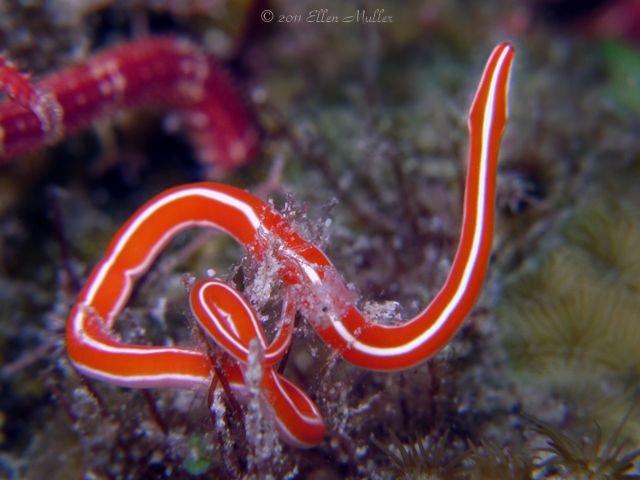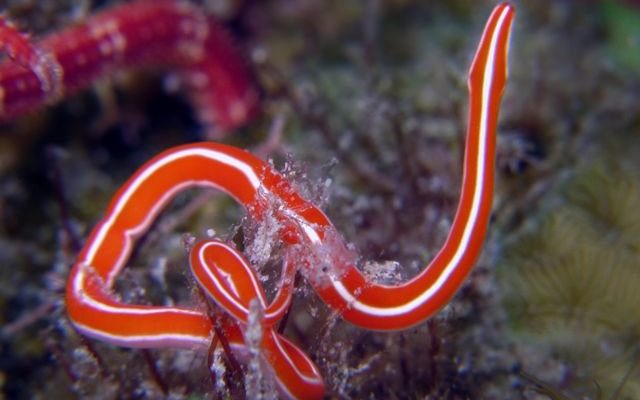
To understand this, let’s dive deeper into the world of ribbon worms and explore their behaviors, habitats, and potential threats they might pose to their fellow ocean dwellers. Imagine you’re sitting across from a friend at your favorite café, sipping coffee, and discussing this intriguing topic. Here’s how the conversation might unfold.
What Exactly Are Ribbon Worms?
Ribbon worms belong to a group called *Nemertea*. They’re known for their elongated bodies that can be brightly colored. You might find these creatures in various marine settings, from sandy shores to rocky tide pools.
With their distinctive shape, ribbon worms are like the ninjas of the ocean. They can be hard to spot, often hiding under rocks or in sand. When they do emerge, it’s usually to hunt for food. They’re not just slender; some ribbon worms can grow up to several feet long!
Ribbon worms are fascinating not just for their appearance but also for their unique biology. They have a specialized structure called a *proboscis* that they use to capture prey. Trust me; it sounds as wild as it looks!
How Do Ribbon Worms Hunt?
Now, you might be wondering how exactly ribbon worms snag their meals. Here’s the thing: they’re not your typical hunters. They use their proboscis to ensnare prey, which usually consists of small fish, crustaceans, and other marine invertebrates.
When a ribbon worm detects potential food, it quickly extends this proboscis, shooting it out with speed and precision. The proboscis can have glue-like substances or even harmful toxins, depending on the species. This unique hunting method means that ribbon worms can be quite effective predators in their environment, often surprising their unsuspecting prey.
So what does this mean for other marine life? Well, it means that ribbon worms can impact local ecosystems, especially if they’re abundant. They help control populations of smaller species but can also threaten them when food is limited.
Are Ribbon Worms Dangerous to Other Marine Creatures?
When it comes to danger, ribbon worms are not the biggest threat in the ocean, but they can still pose risks. Their ability to consume a wide range of smaller creatures means they play a significant role in the balance of marine ecosystems.
In some areas, if ribbon worms thrive, they might outcompete other predators. This could lead to a decline in those species, affecting the broader food web. Additionally, their toxic traits mean that if a predator does make the mistake of munching on a ribbon worm, it could face serious consequences.
But don’t get me wrong; ribbon worms aren’t out for revenge against all marine life. They simply follow their natural instincts. It’s nature’s way of maintaining balance, even if it can be a bit harsh at times.
Human Interaction and Ribbon Worms
You might be thinking, “What about humans?” Well, humans often have a complicated relationship with ribbon worms. While we’re not typically at risk from them, understanding and studying these creatures can provide valuable insights into marine ecosystems.
In some cultures, ribbon worms are used for bait in fishing. A fisherman might find that these slippery, colorful creatures are excellent for attracting certain fish species. On the flip side, if humans disrupt their habitats (like through pollution or habitat destruction), it can lead to an imbalance in local marine life.
So, it’s crucial to respect these creatures and their homes. Keeping our oceans clean and healthy is essential for all marine species, including the ribbon worms.
Where Do Ribbon Worms Live?
Ribbon worms are versatile in their habitat choices. You can find them in various environments, from deep ocean floors to shallow coastal waters. They love to burrow into sandy or muddy substrates, where they can hide from predators and hunt for their next meal.
These worms thrive in many oceanic regions, from temperate to tropical waters. So, whether you’re swimming in the Bahamas or taking a stroll along the Pacific coast, you might be closer to these fascinating creatures than you think.
Their adaptability makes them interesting subjects for researchers. Understanding their distribution helps scientists learn more about marine ecosystems and how various species interact.
What Are the Ecological Roles of Ribbon Worms?
In the grand scheme of things, ribbon worms fulfill essential ecological roles in marine environments. By preying on smaller creatures, they help maintain healthy population levels, ensuring that no single species dominates the ecosystem.
Additionally, their actions can influence the behavior of other marine animals. For instance, their presence can encourage smaller fish to avoid certain areas, leading to more diverse habitats. It’s a bit like how larger animals can influence the movements of smaller ones in land ecosystems.
Protecting these delicate balances is crucial. If ribbon worm populations decline or increase drastically, it can have ripple effects throughout the marine food web.
How Can We Protect Ribbon Worms and Their Habitats?
If you’re passionate about marine life, there are steps you can take to help protect ribbon worms and their habitats. Here are some simple actions you can consider:
- Reduce plastic use: Limiting plastic products can help decrease pollution in our oceans.
- Participate in beach cleanups: Join community efforts to keep coastlines clean and safe for marine creatures.
- Support sustainable fishing: Advocating for responsible fishing practices helps maintain balanced ecosystems.
- Educate others: Sharing knowledge about ribbon worms and marine life can raise awareness about their importance.
Every little action counts, and you don’t have to be a marine biologist to make a difference.
Final Thoughts
So, are ribbon worms dangerous to other marine life? The answer is a bit nuanced. While they can pose a threat to smaller creatures through their hunting methods, they also play vital roles in their ecosystems. Understanding these worms helps us appreciate the complex interactions in the ocean and the importance of preserving marine habitats.
As we continue to explore the wonders of the sea, let’s remember to respect all its inhabitants—ribbon worms included. They’re just doing their thing in the grand ocean dance, reminding us how interconnected life really is beneath the waves.

